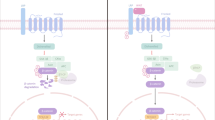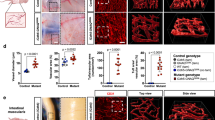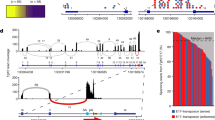Abstract
The incidence of many cancer types is significantly reduced in individuals with Down’s syndrome1,2,3,4, and it is thought that this broad cancer protection is conferred by the increased expression of one or more of the 231 supernumerary genes on the extra copy of chromosome 21. One such gene is Down’s syndrome candidate region-1 (DSCR1, also known as RCAN1), which encodes a protein that suppresses vascular endothelial growth factor (VEGF)-mediated angiogenic signalling by the calcineurin pathway5,6,7,8,9,10. Here we show that DSCR1 is increased in Down’s syndrome tissues and in a mouse model of Down’s syndrome. Furthermore, we show that the modest increase in expression afforded by a single extra transgenic copy of Dscr1 is sufficient to confer significant suppression of tumour growth in mice, and that such resistance is a consequence of a deficit in tumour angiogenesis arising from suppression of the calcineurin pathway. We also provide evidence that attenuation of calcineurin activity by DSCR1, together with another chromosome 21 gene Dyrk1a, may be sufficient to markedly diminish angiogenesis. These data provide a mechanism for the reduced cancer incidence in Down’s syndrome and identify the calcineurin signalling pathway, and its regulators DSCR1 and DYRK1A, as potential therapeutic targets in cancers arising in all individuals.
This is a preview of subscription content, access via your institution
Access options
Subscribe to this journal
Receive 51 print issues and online access
$199.00 per year
only $3.90 per issue
Buy this article
- Purchase on Springer Link
- Instant access to full article PDF
Prices may be subject to local taxes which are calculated during checkout




Similar content being viewed by others
References
Hasle, H., Clemmensen, I. H. & Mikkelsen, M. Risks of leukaemia and solid tumors in individuals with Down’s syndrome. Lancet 355, 165–169 (2000)
Satge, D. et al. A lack of neuroblastoma in Down syndrome: a study from 11 European countries. Cancer Res. 58, 448–452 (1998)
Patja, K., Pukkala, E., Sund, R., Iivanainen, M. & Kaski, M. Cancer incidence of persons with Down syndrome in Finland: a population-based study. Int. J. Cancer 118, 1769–1772 (2006)
Yang, Q., Rasmussen, S. A. & Friedman, J. M. Mortality associated with Down’s syndrome in the USA from 1983 to 1997: a population-based study. Lancet 359, 1019–1025 (2002)
Fuentes, J. J., Pritchard, M. A. & Estivill, X. Genomic organization, alternative splicing, and expression patterns of the DSCR1 (Down syndrome candidate region 1) gene. Genomics 44, 358–361 (1997)
Ryeom, S. et al. Targeted deletion of the calcineurin inhibitor DSCR1 suppresses tumor growth. Cancer Cell 13, 420–431 (2008)
Hesser, B. A. et al. Down syndrome critical region protein 1 (DSCR1), a novel VEGF target gene that regulates expression of inflammatory markers on activated endothelial cells. Blood 104, 149–158 (2004)
Iizuka, M., Abe, M., Shiiba, K., Sasaki, I. & Sato, Y. Down syndrome candidate region 1, a downstream target of VEGF, participates in endothelial cell migration and angiogenesis. J. Vasc. Res. 41, 334–344 (2004)
Minami, T. et al. Vascular endothelial growth factor- and thrombin-induced termination factor, Down syndrome critical region-1, attenuates endothelial cell proliferation and angiogenesis. J. Biol. Chem. 279, 50537–50554 (2004)
Yao, Y. G. & Duh, E. J. VEGF selectively induces Down syndrome critical region 1 gene expression in endothelial cells: a mechanism for feedback regulation of angiogenesis? Biochem. Biophys. Res. Commun. 321, 648–656 (2004)
Fulcher, T. et al. Diabetic retinopathy in Down’s syndrome. Br. J. Ophthalmol. 82, 407–409 (1998)
Murdoch, J. C., Rodger, J. C., Rao, S. S., Fletcher, C. D. & Dunnigan, M. G. Down’s syndrome: an atheroma-free model? BMJ 2, 226–228 (1977)
Olson, L. E., Richtsmeier, J. T., Leszl, J. & Reeves, R. H. A chromosome 21 critical region does not cause specific Down syndrome phenotypes. Science 306, 687–690 (2004)
Reeves, R. H. et al. A mouse model for Down syndrome exhibits learning and behaviour deficits. Nature Genet. 11, 177–184 (1995)
Park, I. H. et al. Disease-specific induced pluripotent stem cells. Cell 134, 877–886 (2008)
Melero-Martin, J. M. et al. Engineering robust and functional vascular networks in vivo with human adult and cord blood-derived progenitor cells. Circ. Res. 103, 194–202 (2008)
Holash, J. et al. Vessel cooption, regression, and growth in tumors mediated by angiopoietins and VEGF. Science 284, 1994–1998 (1999)
Ryeom, S., Greenwald, R. J., Sharpe, A. H. & McKeon, F. The threshold pattern of calcineurin-dependent gene expression is altered by loss of the endogenous inhibitor calcipressin. Nature Immunol. 4, 874 (2003)
Hernandez, G. L. et al. Selective inhibition of vascular endothelial growth factor-mediated angiogenesis by cyclosporin A: roles of the nuclear factor of activated T cells and cyclooxygenase 2. J. Exp. Med. 193, 607–620 (2001)
Arron, J. R. et al. NFAT dysregulation by increased dosage of DSCR1 and DYRK1A on chromosome 21. Nature 441, 595–600 (2006)
Gwack, Y. et al. A genome-wide Drosophila RNAi screen identifies DYRK-family kinases as regulators of NFAT. Nature 441, 646–650 (2006)
Sussan, T. E., Yang, A., Li, F., Ostrowski, M. C. & Reeves, R. H. Trisomy represses ApcMin -mediated tumours in mouse models of Down’s syndrome. Nature 451, 73–75 (2008)
Liu, J. et al. Calcineurin is a common target of cyclophilin-cyclosporin A and FKBP-FK506 complexes. Cell 66, 807–815 (1991)
Dantal, J. & Soulillou, J. P. Immunosuppressive drugs and the risk of cancer after organ transplantation. N. Engl. J. Med. 352, 1371–1373 (2005)
Black, W. C. & Welch, H. G. Advances in diagnostic imaging and overestimations of disease prevalence and the benefits of therapy. N. Engl. J. Med. 328, 1237–1243 (1993)
Harashima, C. et al. Elevated expression of the G-protein-activated inwardly rectifying potassium channel 2 (GIRK2) in cerebellar unipolar brush cells of a Down syndrome mouse model. Cell. Mol. Neurobiol. 26, 719–734 (2006)
Shi, Y. P., Huang, T. T., Carlson, E. J. & Epstein, C. J. The mapping of transgenes by fluorescence in situ hybridization on G-banded mouse chromosomes. Mamm. Genome 5, 337–341 (1994)
Yang, J. et al. Independent signals control expression of the calcineurin inhibitory proteins MCIP1 and MCIP2 in striated muscles. Circ. Res. 87, E61–E68 (2000)
Bronson, S. K. et al. Single-copy transgenic mice with chosen-site integration. Proc. Natl Acad. Sci. USA 93, 9067–9072 (1996)
Giuriato, S. et al. Sustained regression of tumors upon MYC inactivation requires p53 or thrombospondin-1 to reverse the angiogenic switch. Proc. Natl Acad. Sci. USA 103, 16266–16271 (2006)
Acknowledgements
We thank G. Evan, C. Kim, K. Cichowski and J. Italiano for critical discussions and advice. This work was supported by the Howard Hughes Medical Institute (G.Q.D.), Harvard Stem Cell Institute (G.Q.D.), the National Institute of Health Director’s Pioneer Award (G.Q.D.), NHLBI (W.C.A.), Jerome Lejeune Foundation (Z.G.), USUHS (Z.G.), the Smith Family Medical Foundation (S.R.), the Garrett B. Smith Foundation (S.R.) and Annie’s Fun Foundation (S.R.).
Author Contributions K.-H.B., A.Z., R.C.L. and C.B. performed the experiments, analysed the data and generated the figures. I.-H.P. and M.W.L. performed experiments. Y.O., R.J.S., T.M., W.C.A. and Z.G. generated the transgenic mouse models in this manuscript and analysed data. G.Q.D. designed experiments and analysed data. S.S.Y. and J.R.K. contributed to pilot experiments. J.F. and S.R. generated the hypotheses. S.R. designed and performed experiments, analysed the data and wrote the manuscript.
Author information
Authors and Affiliations
Corresponding author
Supplementary information
Supplementary Figures
This file contains Supplementary Figures 1-4 with Legends. (PDF 925 kb)
Rights and permissions
About this article
Cite this article
Baek, KH., Zaslavsky, A., Lynch, R. et al. Down's syndrome suppression of tumour growth and the role of the calcineurin inhibitor DSCR1. Nature 459, 1126–1130 (2009). https://doi.org/10.1038/nature08062
Received:
Accepted:
Published:
Issue Date:
DOI: https://doi.org/10.1038/nature08062
This article is cited by
-
RCAN1-mediated calcineurin inhibition as a target for cancer therapy
Molecular Medicine (2022)
-
The chromosome 21 kinase DYRK1A: emerging roles in cancer biology and potential as a therapeutic target
Oncogene (2022)
-
Establishment of Down’s syndrome periodontal ligament cells by transfection with SV40T-Ag and hTERT
Human Cell (2022)
-
Widespread kidney anomalies in children with Down syndrome
Pediatric Nephrology (2022)
-
RNA-Seq analysis in giant pandas reveals the differential expression of multiple genes involved in cataract formation
BMC Genomic Data (2021)
Comments
By submitting a comment you agree to abide by our Terms and Community Guidelines. If you find something abusive or that does not comply with our terms or guidelines please flag it as inappropriate.



